Rapid microtubule-dependent induction of neurite-like extensions in NIH 3T3 fibroblasts by inhibition of ROCK and Cbl
- PMID: 12960437
- PMCID: PMC266776
- DOI: 10.1091/mbc.e02-11-0739
Rapid microtubule-dependent induction of neurite-like extensions in NIH 3T3 fibroblasts by inhibition of ROCK and Cbl
Abstract
A number of key cellular functions, such as morphological differentiation and cell motility, are closely associated with changes in cytoskeletal dynamics. Many of the principal signaling components involved in actin cytoskeletal dynamics have been identified, and these have been shown to be critically involved in cell motility. In contrast, signaling to microtubules remains relatively uncharacterized, and the importance of signaling pathways in modulation of microtubule dynamics has so far not been established clearly. We report here that the Rho-effector ROCK and the multiadaptor proto-oncoprotein Cbl can profoundly affect the microtubule cytoskeleton. Simultaneous inhibition of these two signaling molecules induces a dramatic rearrangement of the microtubule cytoskeleton into microtubule bundles. The formation of these microtubule bundles, which does not involve signaling by Rac, Cdc42, Crk, phosphatidylinositol 3-kinase, and Abl, is sufficient to induce distinct neurite-like extensions in NIH 3T3 fibroblasts, even in the absence of microfilaments. This novel microtubule-dependent function that promotes neurite-like extensions is not dependent on net changes in microtubule polymerization or stabilization, but rather involves selective elongation and reorganization of microtubules into long bundles.
Figures
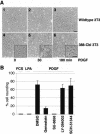
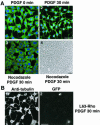
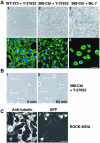
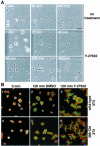
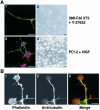


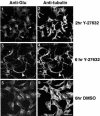

Similar articles
-
Molecular characterization of the effects of Y-27632.Cell Motil Cytoskeleton. 2007 Feb;64(2):97-109. doi: 10.1002/cm.20168. Cell Motil Cytoskeleton. 2007. PMID: 17009325
-
Rho-ROCK signal pathway regulates microtubule-based process formation of cultured podocytes--inhibition of ROCK promoted process elongation.Nephron Exp Nephrol. 2004;97(2):e49-61. doi: 10.1159/000078406. Nephron Exp Nephrol. 2004. PMID: 15218323
-
The multi-adaptor proto-oncoprotein Cbl is a key regulator of Rac and actin assembly.J Cell Sci. 2003 Feb 1;116(Pt 3):463-73. doi: 10.1242/jcs.00244. J Cell Sci. 2003. PMID: 12508108
-
Effect of the Rho-Kinase/ROCK Signaling Pathway on Cytoskeleton Components.Genes (Basel). 2023 Jan 20;14(2):272. doi: 10.3390/genes14020272. Genes (Basel). 2023. PMID: 36833199 Free PMC article. Review.
-
Cytoskeletal and signaling mechanisms of neurite formation.Cell Tissue Res. 2015 Jan;359(1):267-78. doi: 10.1007/s00441-014-1955-0. Epub 2014 Jul 31. Cell Tissue Res. 2015. PMID: 25080065 Free PMC article. Review.
Cited by
-
The flavonoid isoquercitrin promotes neurite elongation by reducing RhoA activity.PLoS One. 2012;7(11):e49979. doi: 10.1371/journal.pone.0049979. Epub 2012 Nov 29. PLoS One. 2012. PMID: 23209630 Free PMC article.
-
The NHERF1 PDZ2 domain regulates PKA-RhoA-p38-mediated NHE1 activation and invasion in breast tumor cells.Mol Biol Cell. 2007 May;18(5):1768-80. doi: 10.1091/mbc.e06-07-0617. Epub 2007 Mar 1. Mol Biol Cell. 2007. PMID: 17332506 Free PMC article.
-
The synovial sarcoma SYT-SSX2 oncogene remodels the cytoskeleton through activation of the ephrin pathway.Mol Biol Cell. 2007 Oct;18(10):4003-12. doi: 10.1091/mbc.e07-05-0496. Epub 2007 Aug 8. Mol Biol Cell. 2007. PMID: 17686994 Free PMC article.
-
Everolimus Stabilizes Podocyte Microtubules via Enhancing TUBB2B and DCDC2 Expression.PLoS One. 2015 Sep 2;10(9):e0137043. doi: 10.1371/journal.pone.0137043. eCollection 2015. PLoS One. 2015. PMID: 26331477 Free PMC article.
-
Emerging evidence on Monkeypox: resurgence, global burden, molecular insights, genomics and possible management.Front Cell Infect Microbiol. 2023 Apr 19;13:1134712. doi: 10.3389/fcimb.2023.1134712. eCollection 2023. Front Cell Infect Microbiol. 2023. PMID: 37153147 Free PMC article. Review.
References
-
- Aspenstrom, P. (1999). Effectors for the Rho GTPases. Curr. Opin. Cell Biol. 11, 95-102. - PubMed
-
- Bachmaier, K., Krawczyk, C., Kozieradzki, I., Kong, Y., Sasaki, T., Olivierados-santos, A., Mariathasan, S.D.B., Wakeham, A., Itle, A., et al. (2000) Negative regulation of lymphocyte activation and autoimmunity by the molecular adaptor Cbl-b. Nature 403, 211-216. - PubMed
-
- Bito, H., Furuyashiki, T., Ishihara, H., Shibasaki, Y., Ohashi, K., Mizuno, K., Maekewa, M., Ishizaki, T., and Narumiya, S. (2000). A critical role for a Rho-associated kinase, p160ROCK in determination of axon outgrowth in mammalian CNS neurons. Neuron 26, 431-441. - PubMed
-
- Chiang, Y.J., Kole, H., Brown, K., Naramura, M., Fukuhara, S., Hu, R.J., Kyung, J., Gutkind, J.S., Shevach, E., and Gu, H. (2000). Cbl-b regulates the CD28 dependence of T-cell activation. Nature 403, 216-220. - PubMed
Publication types
MeSH terms
Substances
LinkOut - more resources
Full Text Sources
Miscellaneous

